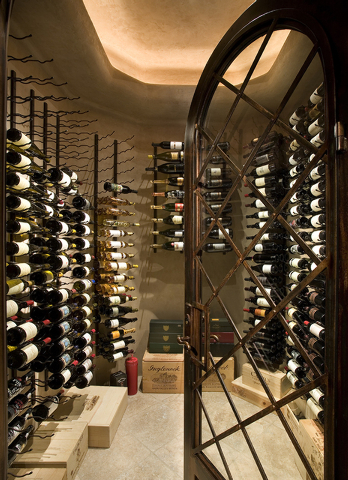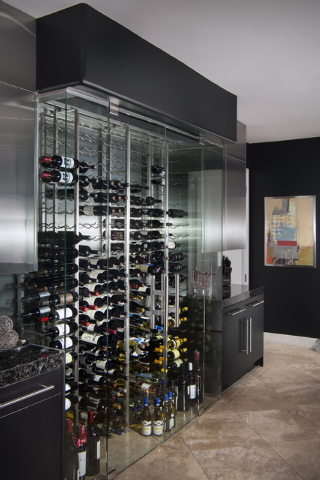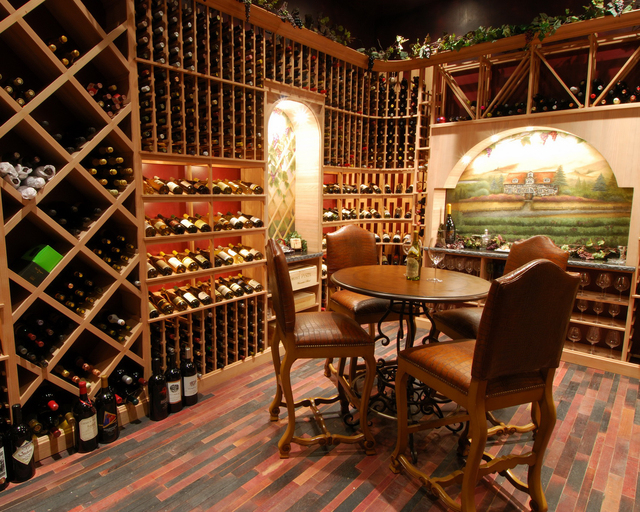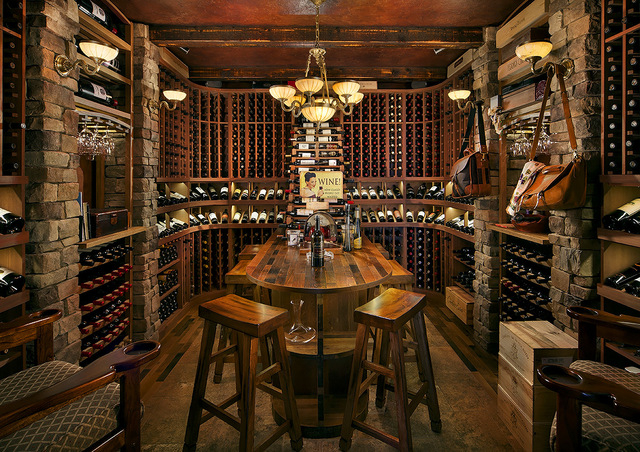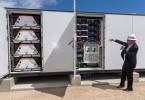Rack It Up
Not everyone has a 1994 Screaming Eagle Cabernet Sauvignon (starting at $2,000) or a 1945 Chateau Mouton-Rothschild Jeroboam ($114,614) in their wine closet. But rest assured if someone did, that wine closet would be quite special.
Storing wine can be done in a variety of ways. Do-it-yourself wine rack kits, usually mahogany, pine or redwood, can be used on their own or as modular components. There are also decorative metal racks.
Wine coolers are more efficient because the thermostat can be adjusted to accommodate different temperature zones within the cooler. Those wine storage units are perfect for all types of oenophiles as they range from six- to 12-bottle units (about the size of a microwave) that can sit on a countertop, to much larger free-standing units that can hold up to 350 bottles. These are about the size of a refrigerator.
According to Larry Gove, wine manager at Total Wine in Henderson, the most important thing to know about wine storage is temperature control.
“Storing wine in Southern Nevada is difficult because of the high summer heat,” he said. “Wines, both red and white, should be in a constant temperature range of 57 to 63 degrees. They don’t do well in an environment much above 70 degrees. Yes, you can keep wine in a wine rack in a dark closet, but for no more than several months.
“Keep in mind that the rule of thumb is that a white wine can be kept four to five years maximum and reds a little longer. But my suggestion is to learn about the wine you’re purchasing and know how long it can be kept in storage. In reality, though, the vast majority of wines being sold today are ready for consumption now.”
Gove bought a 250-bottle, free-standing wine rack in 2002. “It’s still working to perfection,” he said. “It’s nice to have an actual wine room or wine cellar in your home, but for me this was more economical.”
Economical because having a closet or an open area of your home converted into a custom wine room can be expensive. Whether it is installed in a kitchen pantry or the garage, there will have to be new electrical with proper lighting, insulation and moisture-resistant wall board.
Temperature and humidity are the most important. A relative humidity of 60 to 70 percent is ideal for long-term wine storage. The cool temperature slows the aging process, while the high humidity prevents moisture inside the wine bottle from moving into the cork and eventually evaporating into the air.
Ultraviolet light also causes premature aging. It breaks down some of the complex components and may produce unpleasant aromas. Although wine in clear bottles is most susceptible, wine in dark bottles can be affected as well. If wine is kept in a wine rack, keep it out of the light and drink those bottles within several months.
LaVar Short, owner of Frontier Builders, has built both basic and elaborate wine cellars with even a small one costing up to $7,000. But the application is the same on both installations with the main emphasis on temperature.
“Doing it right means having a thermostat installed,” he said. “The floor of the area that’s going to be used for the wine closet needs to be changed to retain cooling, along with several types of installation to repel moisture and water.
“Lighting should be dim so there is no undue warmth in the room. I use can lights recessed into ceiling and I insulate them. Eventually, depending on where the cellar goes, it becomes a room within a room.”
Short said serious wine collectors only want the best and that includes the wine cellar door.
“There is such an expense to buying wines and those bottles need to be kept in a perfect room,” he said. “I install a cold locker door to seal the room. It’s thick and insulated and has a heavy steel-locking bolt with rubber all the way around so when the door closes, the cellar is completely sealed.”
Sandy Horwitz, president of Innovative Wine Cellar Designs, said because of the depressed housing market, many people are remodeling their homes and part of that remodel includes a wine cellar.
“We’ve converted empty bedrooms, areas underneath stairwells, pantries, even powder rooms,” he said. “We do it all and that includes custom wine racking, new flooring, lights, cellar art, refrigeration and remote cellar sensors. It’s a niche market but people understand when I tell them that no matter what they spend on the wine cellar, it’s the least expensive part of their hobby.
“The serious wine collector usually has a minimum 500 bottles at a minimum of $40 to $50 each bottle. But besides that, a handsome, contemporary wine cellar adds to the ambiance of the home and even works as a piece of art that can be the focal point of the home.”
Horwitz has studied wine caves in Italy and France and describes them as “cool, moist, dark and dry. They are a perfect environment for wines to age properly over five to 10 years and we build our wine cellars to emulate that.”
So no matter if you have a 12-bottle wine rack in the food pantry or a modern wine cellar that holds 1,000 bottles of select wines, remember the three rules about storing wine:
■ Keep the storage area dark since wines don’t like sunlight;
■ Keep the storage area and surrounding area still as wines don’t like vibration;
■ Keep the wine storage area at a constant temperature.
And finally, wine should be stored on its side so that the wine is in contact with the cork at all times, keeping the cork wet. Lower humidity levels will dry the air side of the cork allowing oxygen to come in contact with the wine causing immediate aging.
Salud.




